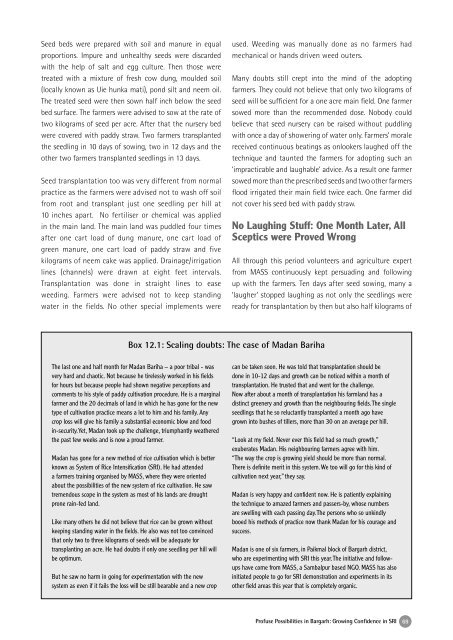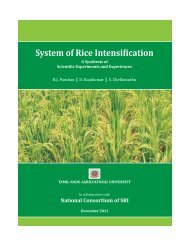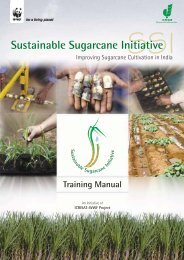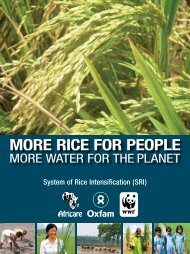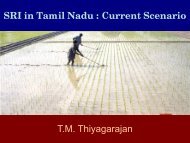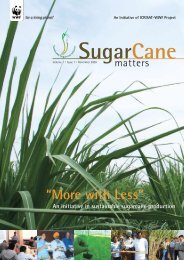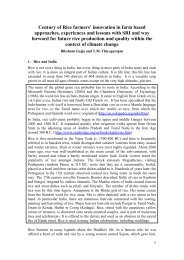SRI in Orissa - Cornell International Institute for Food, Agriculture ...
SRI in Orissa - Cornell International Institute for Food, Agriculture ...
SRI in Orissa - Cornell International Institute for Food, Agriculture ...
You also want an ePaper? Increase the reach of your titles
YUMPU automatically turns print PDFs into web optimized ePapers that Google loves.
Seed beds were prepared with soil and manure <strong>in</strong> equal<br />
proportions. Impure and unhealthy seeds were discarded<br />
with the help of salt and egg culture. Then those were<br />
treated with a mixture of fresh cow dung, moulded soil<br />
(locally known as Uie hunka mati), pond silt and neem oil.<br />
The treated seed were then sown half <strong>in</strong>ch below the seed<br />
bed surface. The farmers were advised to sow at the rate of<br />
two kilograms of seed per acre. After that the nursery bed<br />
were covered with paddy straw. Two farmers transplanted<br />
the seedl<strong>in</strong>g <strong>in</strong> 10 days of sow<strong>in</strong>g, two <strong>in</strong> 12 days and the<br />
other two farmers transplanted seedl<strong>in</strong>gs <strong>in</strong> 13 days.<br />
Seed transplantation too was very different from normal<br />
practice as the farmers were advised not to wash off soil<br />
from root and transplant just one seedl<strong>in</strong>g per hill at<br />
10 <strong>in</strong>ches apart. No fertiliser or chemical was applied<br />
<strong>in</strong> the ma<strong>in</strong> land. The ma<strong>in</strong> land was puddled four times<br />
after one cart load of dung manure, one cart load of<br />
green manure, one cart load of paddy straw and five<br />
kilograms of neem cake was applied. Dra<strong>in</strong>age/irrigation<br />
l<strong>in</strong>es (channels) were drawn at eight feet <strong>in</strong>tervals.<br />
Transplantation was done <strong>in</strong> straight l<strong>in</strong>es to ease<br />
weed<strong>in</strong>g. Farmers were advised not to keep stand<strong>in</strong>g<br />
water <strong>in</strong> the fields. No other special implements were<br />
used. Weed<strong>in</strong>g was manually done as no farmers had<br />
mechanical or hands driven weed outers.<br />
Many doubts still crept <strong>in</strong>to the m<strong>in</strong>d of the adopt<strong>in</strong>g<br />
farmers. They could not believe that only two kilograms of<br />
seed will be sufficient <strong>for</strong> a one acre ma<strong>in</strong> field. One farmer<br />
sowed more than the recommended dose. Nobody could<br />
believe that seed nursery can be raised without puddl<strong>in</strong>g<br />
with once a day of shower<strong>in</strong>g of water only. Farmers’ morale<br />
received cont<strong>in</strong>uous beat<strong>in</strong>gs as onlookers laughed off the<br />
technique and taunted the farmers <strong>for</strong> adopt<strong>in</strong>g such an<br />
‘impracticable and laughable’ advice. As a result one farmer<br />
sowed more than the prescribed seeds and two other farmers<br />
flood irrigated their ma<strong>in</strong> field twice each. One farmer did<br />
not cover his seed bed with paddy straw.<br />
No Laugh<strong>in</strong>g Stuff: One Month Later, All<br />
Sceptics were Proved Wrong<br />
All through this period volunteers and agriculture expert<br />
from MASS cont<strong>in</strong>uously kept persuad<strong>in</strong>g and follow<strong>in</strong>g<br />
up with the farmers. Ten days after seed sow<strong>in</strong>g, many a<br />
‘laugher’ stopped laugh<strong>in</strong>g as not only the seedl<strong>in</strong>gs were<br />
ready <strong>for</strong> transplantation by then but also half kilograms of<br />
Box 12.1: Scal<strong>in</strong>g doubts: The case of Madan Bariha<br />
The last one and half month <strong>for</strong> Madan Bariha – a poor tribal - was<br />
very hard and chaotic. Not because he tirelessly worked <strong>in</strong> his fields<br />
<strong>for</strong> hours but because people had shown negative perceptions and<br />
comments to his style of paddy cultivation procedure. He is a marg<strong>in</strong>al<br />
farmer and the 20 decimals of land <strong>in</strong> which he has gone <strong>for</strong> the new<br />
type of cultivation practice means a lot to him and his family. Any<br />
crop loss will give his family a substantial economic blow and food<br />
<strong>in</strong>-security. Yet, Madan took up the challenge, triumphantly weathered<br />
the past few weeks and is now a proud farmer.<br />
Madan has gone <strong>for</strong> a new method of rice cultivation which is better<br />
known as System of Rice Intensification (<strong>SRI</strong>). He had attended<br />
a farmers tra<strong>in</strong><strong>in</strong>g organised by MASS, where they were oriented<br />
about the possibilities of the new system of rice cultivation. He saw<br />
tremendous scope <strong>in</strong> the system as most of his lands are drought<br />
prone ra<strong>in</strong>-fed land.<br />
Like many others he did not believe that rice can be grown without<br />
keep<strong>in</strong>g stand<strong>in</strong>g water <strong>in</strong> the fields. He also was not too conv<strong>in</strong>ced<br />
that only two to three kilograms of seeds will be adequate <strong>for</strong><br />
transplant<strong>in</strong>g an acre. He had doubts if only one seedl<strong>in</strong>g per hill will<br />
be optimum.<br />
But he saw no harm <strong>in</strong> go<strong>in</strong>g <strong>for</strong> experimentation with the new<br />
system as even if it fails the loss will be still bearable and a new crop<br />
can be taken soon. He was told that transplantation should be<br />
done <strong>in</strong> 10-12 days and growth can be noticed with<strong>in</strong> a month of<br />
transplantation. He trusted that and went <strong>for</strong> the challenge.<br />
Now after about a month of transplantation his farmland has a<br />
dist<strong>in</strong>ct greenery and growth than the neighbour<strong>in</strong>g fields. The s<strong>in</strong>gle<br />
seedl<strong>in</strong>gs that he so reluctantly transplanted a month ago have<br />
grown <strong>in</strong>to bushes of tillers, more than 30 on an average per hill.<br />
“Look at my field. Never ever this field had so much growth,”<br />
exuberates Madan. His neighbour<strong>in</strong>g farmers agree with him.<br />
“The way the crop is grow<strong>in</strong>g yield should be more than normal.<br />
There is def<strong>in</strong>ite merit <strong>in</strong> this system. We too will go <strong>for</strong> this k<strong>in</strong>d of<br />
cultivation next year,” they say.<br />
Madan is very happy and confident now. He is patiently expla<strong>in</strong><strong>in</strong>g<br />
the technique to amazed farmers and passers-by, whose numbers<br />
are swell<strong>in</strong>g with each pass<strong>in</strong>g day. The persons who so unk<strong>in</strong>dly<br />
booed his methods of practice now thank Madan <strong>for</strong> his courage and<br />
success.<br />
Madan is one of six farmers, <strong>in</strong> Paikmal block of Bargarh district,<br />
who are experiment<strong>in</strong>g with <strong>SRI</strong> this year. The <strong>in</strong>itiative and followups<br />
have come from MASS, a Sambalpur based NGO. MASS has also<br />
<strong>in</strong>itiated people to go <strong>for</strong> <strong>SRI</strong> demonstration and experiments <strong>in</strong> its<br />
other field areas this year that is completely organic.<br />
Profuse Possibilities <strong>in</strong> Bargarh: Grow<strong>in</strong>g Confidence <strong>in</strong> <strong>SRI</strong> 69


